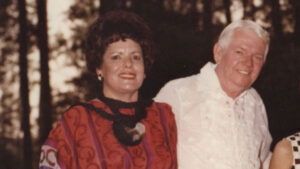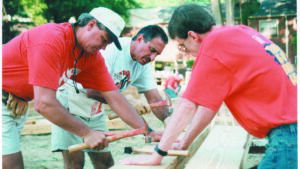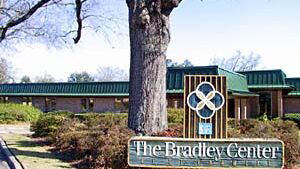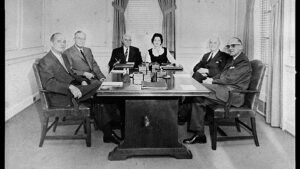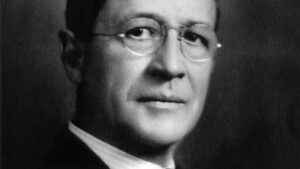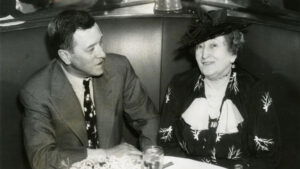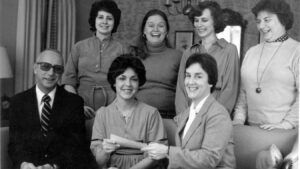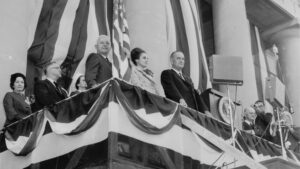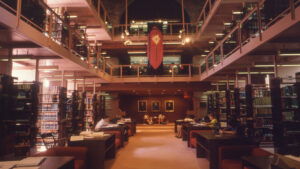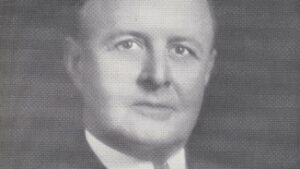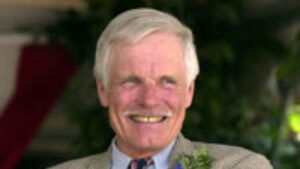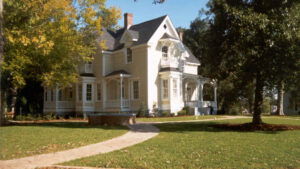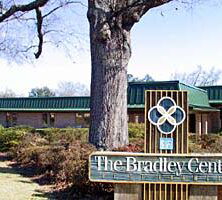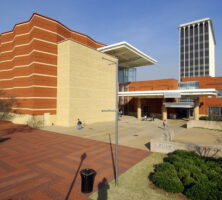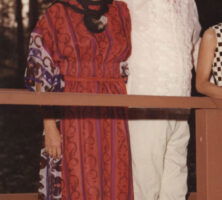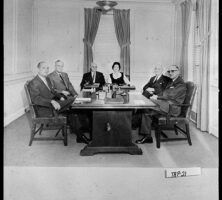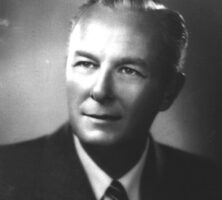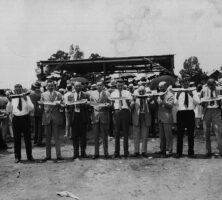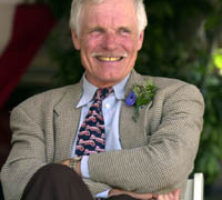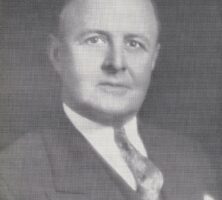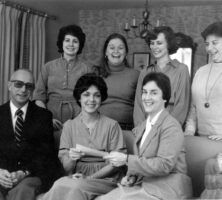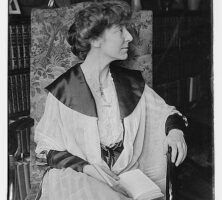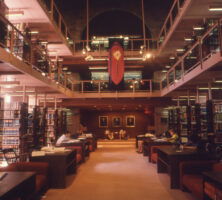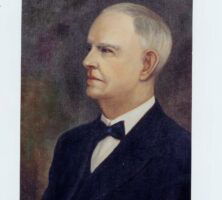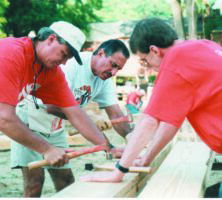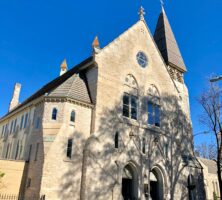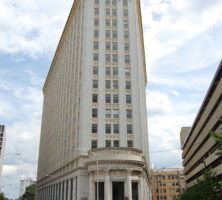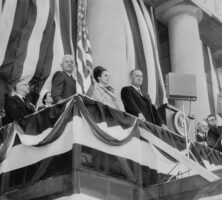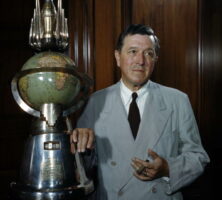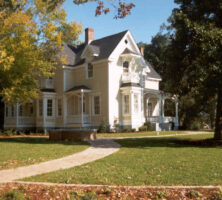The New Georgia Encyclopedia is supported by funding from A More Perfect Union, a special initiative of the National Endowment for the Humanities.
Robert Woodruff, the president of the Coca-Cola Company, is pictured with Lettie Pate Whitehead Evans at the Stork Club in New York City, during the 1940s. Evans owned the Atlanta Coca-Cola Bottling Company, founded by her husband Joseph Whitehead, for several decades before selling it to Woodruff in 1932.
The New Georgia Encyclopedia does not hold the copyright for this media resource and can neither grant nor deny permission to republish or reproduce the image online or in print. For more information about this resource, contact the Stuart A. Rose Manuscript, Archives, and Rare Book Library at Emory University.
Lettie Pate Whitehead Evans, a Virginia native, was a prominent businesswoman and philanthropist in Atlanta during the first half of the twentieth century. In 1932 she joined the board of directors for the Coca-Cola Company, becoming one of the first women in the country to serve on the board of a major corporation.
The New Georgia Encyclopedia does not hold the copyright for this media resource and can neither grant nor deny permission to republish or reproduce the image online or in print. For more information about this resource, contact the Stuart A. Rose Manuscript, Archives, and Rare Book Library at Emory University.
HealthVoices is a publication of the Healthcare Georgia Foundation that focuses on public health policy in the state and covers topics ranging from health insurance to taxes on tobacco.
The New Georgia Encyclopedia does not hold the copyright for this media resource and can neither grant nor deny permission to republish or reproduce the image online or in print. All requests for permission to publish or reproduce the resource must be submitted to the rights holder.
The New Georgia Encyclopedia does not hold the copyright for this media resource and can neither grant nor deny permission to republish or reproduce the image online or in print. All requests for permission to publish or reproduce the resource must be submitted to the rights holder.
The Bradley Center, a psychiatric hospital in Columbus, was established by the Bradley-Turner Foundation in 1955. Today the hospital is affiliated with St. Francis Hospital in Columbus and offers outpatient counseling and social services to the public.
Photograph by Kate Howard, New Georgia Encyclopedia
The New Georgia Encyclopedia does not hold the copyright for this media resource and can neither grant nor deny permission to republish or reproduce the image online or in print. All requests for permission to publish or reproduce the resource must be submitted to the rights holder.
The New Georgia Encyclopedia does not hold the copyright for this media resource and can neither grant nor deny permission to republish or reproduce the image online or in print. All requests for permission to publish or reproduce the resource must be submitted to the rights holder.
The New Georgia Encyclopedia does not hold the copyright for this media resource and can neither grant nor deny permission to republish or reproduce the image online or in print. All requests for permission to publish or reproduce the resource must be submitted to the rights holder.
The RiverCenter for the Performing Arts in Columbus was built with a $20 million gift from the Bradley-Turner Foundation and matching gifts from other arts agencies in Columbus.
Image from Visit Columbus GA
The New Georgia Encyclopedia does not hold the copyright for this media resource and can neither grant nor deny permission to republish or reproduce the image online or in print. All requests for permission to publish or reproduce the resource must be submitted to the rights holder.
Elena Diaz-Verson Amos poses with her husband, Aflac cofounder John Amos, in the 1980s. Born in Havana, Cuba, Amos studied as an exchange student at the University of Miami in Florida and remained active in Cuban advocacy and humanitarian causes throughout her life. In 1955 she and her husband moved to Columbus, where she became active in a variety of philanthropic causes.
Courtesy of Aflac
The New Georgia Encyclopedia does not hold the copyright for this media resource and can neither grant nor deny permission to republish or reproduce the image online or in print. All requests for permission to publish or reproduce the resource must be submitted to the rights holder.
The New Georgia Encyclopedia does not hold the copyright for this media resource and can neither grant nor deny permission to republish or reproduce the image online or in print. All requests for permission to publish or reproduce the resource must be submitted to the rights holder.
The trustees of the Callaway Community Foundation, founded by Fuller E. Callaway Jr., meet in 1956. From left: Arthur B. Edge Jr., Callaway, Hatton Lovejoy, Mrs. Fuller E. Callaway Jr., William H. Turner, Glenn Simpson.
Courtesy of Georgia Archives, Vanishing Georgia, #
trp021.
The New Georgia Encyclopedia does not hold the copyright for this media resource and can neither grant nor deny permission to republish or reproduce the image online or in print. Requests for permission to publish or reproduce the resource should be submitted to the Georgia Archives.
Fuller E. Callaway Jr. founded the Callaway Community Foundation, which offered charitable assistance to the employees of the Callaway Mills, in 1943. Today the Callaway Foundation offers grants for a variety of projects around Georgia, particularly in the LaGrange area.
Courtesy of Troup County Archives, LaGrange, Callaway Educational Association Photo Collection.
The New Georgia Encyclopedia does not hold the copyright for this media resource and can neither grant nor deny permission to republish or reproduce the image online or in print. All requests for permission to publish or reproduce the resource must be submitted to the rights holder.
After Fuller E. Callaway died, employees of Callaway Mills gathered each year on his birthday, July 15, for a company-sponsored picnic. Fuller E. Callaway Jr. (second from left) is shown enjoying watermelon with other workers of Callaway Mills.
Courtesy of Troup County Archives, LaGrange, Callaway Educational Association Collection.
The New Georgia Encyclopedia does not hold the copyright for this media resource and can neither grant nor deny permission to republish or reproduce the image online or in print. All requests for permission to publish or reproduce the resource must be submitted to the rights holder.
CNN founder Ted Turner became vice chair of Time Warner after the media giant bought Turner Broadcasting System in 1995. In 2001 Time Warner merged with the Internet service provider America Online, creating the world's largest media conglomerate.
Courtesy of Atlanta Journal-Constitution.
The New Georgia Encyclopedia does not hold the copyright for this media resource and can neither grant nor deny permission to republish or reproduce the image online or in print. All requests for permission to publish or reproduce the resource must be submitted to the Atlanta Journal-Constitution.
The Goizueta Business School at Emory University began construction on the Goizueta Foundation Center for Research and Doctoral Education, a $33.4 million addition, in 2004.
Courtesy of Kallmann McKinnell and Wood Architects, Inc.
The New Georgia Encyclopedia does not hold the copyright for this media resource and can neither grant nor deny permission to republish or reproduce the image online or in print. All requests for permission to publish or reproduce the resource must be submitted to the rights holder.
The New Georgia Encyclopedia does not hold the copyright for this media resource and can neither grant nor deny permission to republish or reproduce the image online or in print. All requests for permission to publish or reproduce the resource must be submitted to the rights holder.
Joseph M. Tull, who grew up in North Carolina, attended college after finishing grammar school because his area had no high school. He went on to become a successful businessman and entrepreneur in Atlanta, where he established the J. M. Tull Foundation, known today as the Tull Charitable Foundation.
From J. M. Tull: The Man, the Company, by F. M. Garrett
The New Georgia Encyclopedia does not hold the copyright for this media resource and can neither grant nor deny permission to republish or reproduce the image online or in print. All requests for permission to publish or reproduce the resource must be submitted to the rights holder.
The New Georgia Encyclopedia does not hold the copyright for this media resource and can neither grant nor deny permission to republish or reproduce the image online or in print. All requests for permission to publish or reproduce the resource must be submitted to the rights holder.
The founders of the Jeannette Rankin Foundation present the organization's first grant to Barbara Dixon, a student at Athens Technical College, in 1978. Standing, from left: Gail Dendy, Heather Kleiner, Margaret Holt, Reita Rivers. Seated, from left: Fred Friedricks (of Athens Technical College), Barbara Dixon, and Sue Bailey.
Courtesy of Jeannette Rankin Foundation
The New Georgia Encyclopedia does not hold the copyright for this media resource and can neither grant nor deny permission to republish or reproduce the image online or in print. All requests for permission to publish or reproduce the resource must be submitted to the rights holder.
Jeannette Rankin, a native of Montana, became the first woman elected to the U.S. House of Representatives in 1916 and later purchased property in Georgia, first in Bogart and then in Watksinsville. After her death in 1973, proceeds from the sale of her Watkinsville land were used in 1976 to found the Jeannette Rankin Foundation, which is headquartered in Athens.
Courtesy of Library of Congress, Prints and Photographs Division, George Grantham Bain Collection, #LC-DIG-ggbain-23835.
The New Georgia Encyclopedia does not hold the copyright for this media resource and can neither grant nor deny permission to republish or reproduce the image online or in print. All requests for permission to publish or reproduce the resource must be submitted to the rights holder.
With the aid of monetary donations from Margaret Adger Pitts, the Pitts Theology Library has grown to contain more than 520,000 volumes in several languages. The library, located at Emory University, also subscribes to more than 1,500 periodicals.
Courtesy of Emory University Photo
The New Georgia Encyclopedia does not hold the copyright for this media resource and can neither grant nor deny permission to republish or reproduce the image online or in print. All requests for permission to publish or reproduce the resource must be submitted to the rights holder.
William Irby Hudson Pitts established the William I. H. and Lula E. Pitts Foundation, which funds various efforts of the United Methodist Church, in 1941. Large donations from the foundation have supported Andrew College, Candler School of Theology, Epworth by the Sea, LaGrange College, Magnolia Manor, and Young Harris College.
Courtesy of SunTrust Bank, Endowment and Foundation Services
The New Georgia Encyclopedia does not hold the copyright for this media resource and can neither grant nor deny permission to republish or reproduce the image online or in print. All requests for permission to publish or reproduce the resource must be submitted to the rights holder.
A crew from the Arthur M. Blank Family Foundation, headquarted in Atlanta, drives nails during a Habitat for Humanity house-raising. Arthur Blank, center, cofounded The Home Depot in 1979 and established the foundation in 1995.
Courtesy of Arthur M. Blank Family Foundation
The New Georgia Encyclopedia does not hold the copyright for this media resource and can neither grant nor deny permission to republish or reproduce the image online or in print. All requests for permission to publish or reproduce the resource must be submitted to the rights holder.
The Arthur M. Blank Family Foundation was established by Arthur Blank, cofounder of the Home Depot, in 1995. Standing, from left: Arthur Blank, Stephanie Blank, Penelope McPhee (foundation president), Kenny Blank, Nancy Blank, and Michael Blank. Seated, from left: Danielle Blank and Dena Blank.
Courtesy of Arthur M. Blank Family Foundation
The New Georgia Encyclopedia does not hold the copyright for this media resource and can neither grant nor deny permission to republish or reproduce the image online or in print. All requests for permission to publish or reproduce the resource must be submitted to the rights holder.
The New Georgia Encyclopedia does not hold the copyright for this media resource and can neither grant nor deny permission to republish or reproduce the image online or in print. All requests for permission to publish or reproduce the resource must be submitted to the rights holder.
John Bulow Campbell, whose estate allowed for the creation of the J. Bulow Campbell Foundation after his death, believed that humility, charity, and service were necessary elements of a Christian life. His philanthropy flowed from this conviction.
Courtesy of the J. Bulow Campbell Foundation
The New Georgia Encyclopedia does not hold the copyright for this media resource and can neither grant nor deny permission to republish or reproduce the image online or in print. All requests for permission to publish or reproduce the resource must be submitted to the rights holder.
Many consider the English Gothic–style Central Presbyterian Church in Atlanta (1885) to be architect Edmund G. Lind's greatest building.
Image from Warren LeMay
The New Georgia Encyclopedia does not hold the copyright for this media resource and can neither grant nor deny permission to republish or reproduce the image online or in print. All requests for permission to publish or reproduce the resource must be submitted to the rights holder.
The Hurt Building, named for Atlanta developer Joel Hurt and completed in 1926, was the seventeenth-largest office building in the world; still standing, it remains a distinctive Atlanta landmark.
Photograph by Ganeshk
The New Georgia Encyclopedia does not hold the copyright for this media resource and can neither grant nor deny permission to republish or reproduce the image online or in print. All requests for permission to publish or reproduce the resource must be submitted to the rights holder.
Peyton Anderson, publisher of the Macon Telegraph and active community member, campaigns with Lady Bird and Lyndon Johnson in Macon in 1964. The man to the far right with crossed arms is U.S. representative Carl Vinson.
Courtesy Peyton Anderson Foundation
The New Georgia Encyclopedia does not hold the copyright for this media resource and can neither grant nor deny permission to republish or reproduce the image online or in print. All requests for permission to publish or reproduce the resource must be submitted to the rights holder.
The New Georgia Encyclopedia does not hold the copyright for this media resource and can neither grant nor deny permission to republish or reproduce the image online or in print. All requests for permission to publish or reproduce the resource must be submitted to the rights holder.
Robert W. Woodruff became president of both the Trust Company of Georgia and the Coca-Cola Company in 1923 and eventually became the architect of Coke's worldwide expansion. In later years Woodruff was also Emory University's greatest benefactor. In 1937 he established the Robert W. Woodruff Foundation, a charitable organization.
Image from oaktree_b
The New Georgia Encyclopedia does not hold the copyright for this media resource and can neither grant nor deny permission to republish or reproduce the image online or in print. All requests for permission to publish or reproduce the resource must be submitted to the rights holder.
The Robert Woodruff Foundation was instrumental in the development of Centennial Olympic Park in Atlanta.
Courtesy of Explore Georgia, Photograph by Ralph Daniel.
The New Georgia Encyclopedia does not hold the copyright for this media resource and can neither grant nor deny permission to republish or reproduce the image online or in print. Requests for permission to publish or reproduce the resource may need to be submitted to Explore Georgia.
Georgia politician Thomas E. Watson purchased a home in Thomson in 1881 and lived there until 1904. The home is now a National Historic Landmark and serves as the administrative headquarters for the Watson-Brown Foundation.
Courtesy of Watson-Brown Foundation, Inc.
The New Georgia Encyclopedia does not hold the copyright for this media resource and can neither grant nor deny permission to republish or reproduce the image online or in print. All requests for permission to publish or reproduce the resource must be submitted to the rights holder.
The New Georgia Encyclopedia does not hold the copyright for this media resource and can neither grant nor deny permission to republish or reproduce the image online or in print. All requests for permission to publish or reproduce the resource must be submitted to the rights holder.
